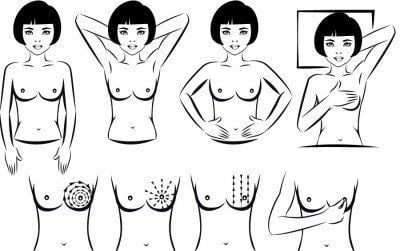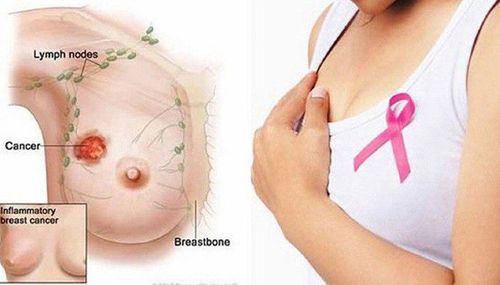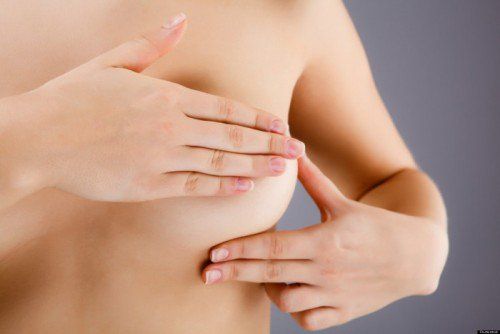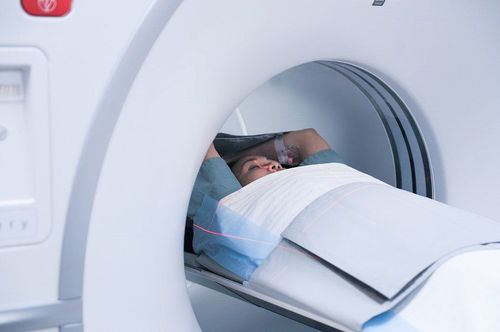This is an automatically translated article.
The article was professionally consulted by Specialist Doctor II Do Tuong Huan - Oncologist - Oncology Center - Vinmec Central Park International General Hospital.Breast self-examination at home is an important way to detect breast cancer early, increasing the likelihood of successful treatment. If every woman can practice breast self-examination skills, combined with regular screening methods will help timely prognosis and better treatment results.
1. Guide to breast self-examination at home
Breast self-examination at home is extremely simple that every woman needs to know to do for herself. However, it is necessary to understand the order and how to do the examination to be effective, to avoid missing the warning signs right from the time of onset.The order of breast examination consists of 5 steps presented in turn as follows:
Step 1:
Start by looking at your breasts in the mirror with your shoulders straight and your hands resting on your hips.
Here's what you need to note:
Breasts are the same size, shape and color as usual; The breasts have a uniform appearance on both sides, with no distortion or swelling. If you see any of the following changes, see your doctor as soon as possible:
Peeling, wrinkling, or swelling; One side of the nipple has changed position or the nipple is retracted inward; Redness, pain, rash or swelling in any part of the breast.

Kiểm tra vú bằng cách quan sát vào ngực của mình trong gương
You raise both arms high and look for the changes as above. Step 3:
You look in the mirror, look for signs of discharge from 1 or both nipples. This can be liquid, milky, yellow, or it can also be blood. Step 4:
Next, examine your breasts in a supine position using your right hand to feel your left breast and vice versa. The operation needs to be gentle, slow but still firm and smooth with the tips of the fingers. Always keep your fingers straight and together while bringing your hand in a circular motion that fits 1/4 of each breast to the end of the entire breast. It is necessary to follow a certain sequence, from top to bottom, from side to side. Always remember this sequence of exams and apply it consistently each time to make sure you have palpated the entire breast parenchyma. If you don't choose to examine the circle every quarter, you can choose to start at the nipple, moving in larger circles until you reach the outer edge of the breast. You can also move your finger up and down vertically or horizontally. During palpation, be sure to feel density over all tissues from the front to the back of your chest. Accordingly, for the skin and tissue just below the skin, use light pressure; Next, apply medium pressure to the tissue in the middle of the chest and apply high pressure to the deep tissue in the back. A sign that you have reached deep tissue is that you should be able to feel down your rib cage.

Tự khám vú tại nhà là biện pháp giúp phát hiện sớm ung thư vú
Finally, feel and observe your entire chest while standing or sitting. Many women find that the easiest way to feel their breasts is when the skin is wet and slippery, so they prefer to do this step in the shower. Don't miss any part of your breast using the same hand movements described in step 4.
2. What to do if you find breast lumps?
Don't panic if you feel a lump in your breast at the first visit. The reason is that some women may have lumps in the breast and most of these lumps are benign (not cancerous at all). Noncancerous breast lumps are caused by hormonal changes during pregnancy, menstruation, benign breast conditions, or trauma.However, a professional examination as well as necessary tests can be done to ensure that breast lumps are not a cause for concern. Therefore, the best thing to do is to see your doctor when you have noticed a lump as well as changes in the breast such as discharge, skin shrinkage. This should be of particular concern if these changes persist for more than 1 menstrual cycle.
At the appointment, the doctor will check with the naked eye and palpate with the fingertips to give the most complete description of the characteristics of the lump in the breast parenchyma. In addition, the surrounding lymph node system, such as in the supraclavicular fossa, in the axillary fossa should also be investigated. The process is similar to the self-manipulation as described, ensuring the entire breast tissue protrusion and is even on both sides.
Besides, ultrasound indication will also be reached. This is the first imaging tool to evaluate a tumor, especially in women under 30 years of age or who are pregnant or breast-feeding. For women over 30 years of age or not pregnant or breastfeeding, the alternative is a mammogram. If either of the ultrasound and mammogram results are suspicious, the doctor will order additional imaging studies such as magnetic resonance imaging (MRI), molecular mammography ( MBI) and/or biopsy to find out what the tumor is.

Chụp X-quang tuyến vú nhằm xác định tình trạng u vú chuẩn xác
3. How to do a breast self-exam properly to help screen for breast cancer?
There is no other way than doing it regularly. The more times you examine your breasts, the more you will know about them and the easier it will be to tell if something suddenly changes.Accordingly, every woman, right from puberty, should get into the habit of doing breast self-examination in front of a mirror at least once a month to get used to how your breasts normally look and feel. The best time to do a breast self-exam is a few days after your period ends. This is when your breasts are no longer swollen and sensitive due to the hormones involved in ovulation. If you no longer have your period, choose a date that is easy to remember, such as the first or last day of the month.
Besides, breast cancer screening will be comprehensively effective if a woman adheres to regular health checks, has general gynecological cancer examinations and tests, including cervical cancer screening. uterus .
4. Breast cancer screening at Vinmec
Currently, to join hands in "Say no to breast cancer", Vinmec International General Hospital has built a breast cancer screening package including: Breast examination with an oncologist or a gynecologist; Mammogram (2 sides); 2D breast ultrasound on both sides.,..
Advantages of breast cancer screening at Vinmec:
Team of highly qualified and experienced doctors; Comprehensive professional cooperation with domestic and international hospitals: Singapore, Japan, USA, ..; Comprehensive treatment and care of patients, multi-specialty coordination towards individualizing each patient; Having a full range of specialized facilities for diagnosis and staging before treatment: Endoscopy, CT scan, PET-CT scan, MRI, histopathological diagnosis, gene-cell testing, .. .; There are full range of main cancer treatment methods: surgery, radiation therapy, chemotherapy, stem cell transplant... Breast cancer screening package at Vinmec for the following subjects:
Female customers, over 40 years old; Customers wishing to be able to screen for breast cancer pathology; Customers with high risk of cancer – especially customers with a family history of breast cancer; Women of reproductive age, perimenopause and menopause; Women who have symptoms that are suspected of breast cancer such as pain in the breast, lump in the breast ...
Please dial HOTLINE for more information or register for an appointment HERE. Download MyVinmec app to make appointments faster and to manage your bookings easily.













